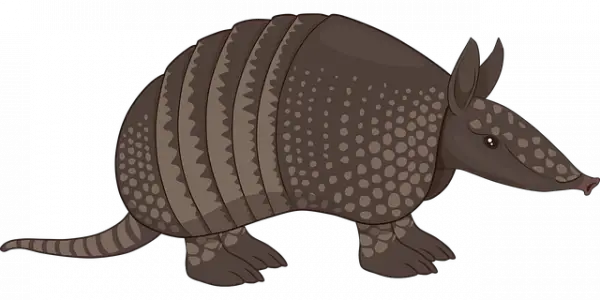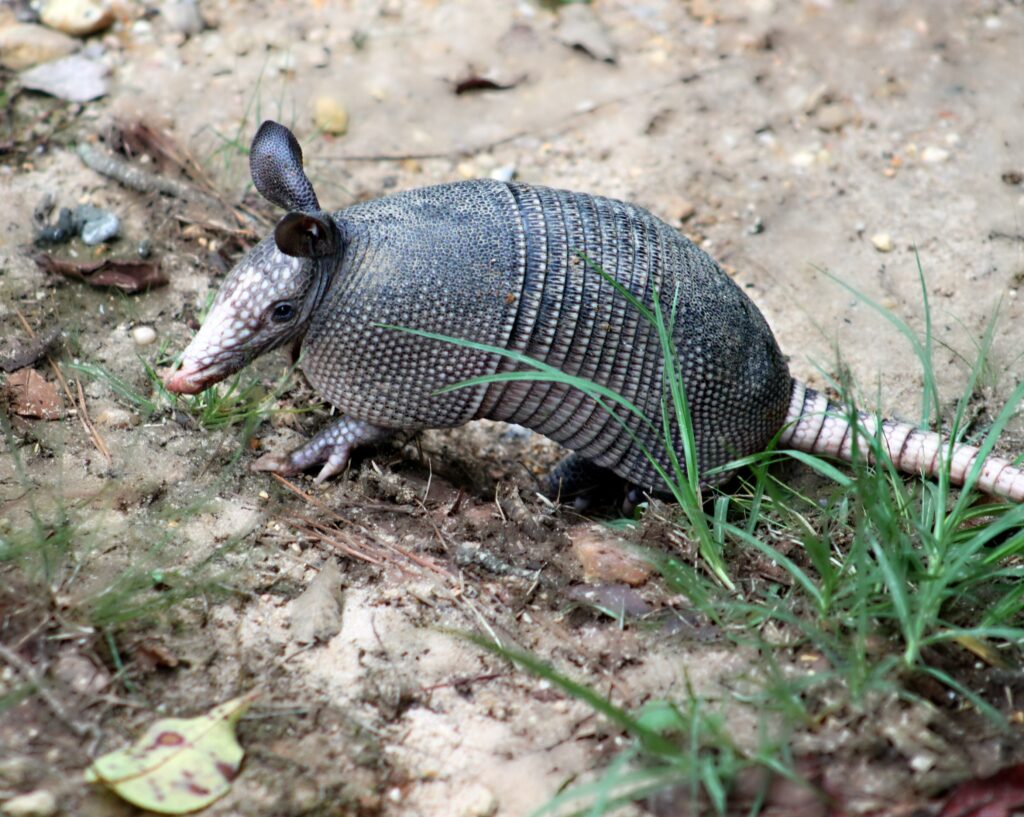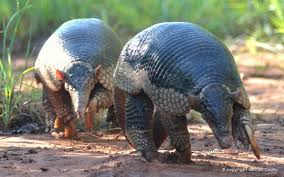After all, which animates are addressed by the word Armadillo? What makes an animal fit that term? An armadillo is a mammalian animal (has mammary glands), belonging to the Cingulata order and the Dasypodidae family. The characteristic visible to our eyes that most brings back memories of the armadillo is the massive structure that it presents on its dorsal part. This carcass is seen as armor, which often provides some kind of protection. These animals are native to the American continent, and have as their natural habitat, various vegetation from various parts of the world: savannas, cerrados, riparian forests, and wet forests.
The etymology of the word armadillo is given by the derivation of ta’tu, which in Tupi means dense bark. Biologically classifying the armadillo, we have that the kingdom is Animalia , the phylum is Chordata , the class is Mammalia , the infra class is Eutheria , the super order is Xenarthra , the order is Cingulata and Familia Dasypodidae.
One of the most curious characteristics of these animals is their uses for medicine. Few people know, but the only living being capable of contracting leprosy is the armadillo. This makes the armadillo an animal that is the object of study all over the world, since there is an eternal academic vacuum in understanding the causes and treatment of the disease. Leprosy can be transmitted by eating armadillo meat, and it is worth remembering that even armadillo hunting can become a potential vector of the disease.

Armadillo
A great importance of the armadillo (in addition to studies on leprosy) is its role in the ecological chain. Armadillos are great insect killers (characterizing themselves as insectivorous animals), which causes the population of ants and termites to decrease drastically. To get an idea of the number of ants that this animal ingests, a recent survey by a large university in southern Brazil concluded that the 2.5-kilogram armadillo can ingest a total of up to 9,000 ants in a single night. ants.
Once we are aware of all these beneficial factors of armadillos, we realize that when we hunt armadillos to eat their meat, it causes such an environmental imbalance that the number of ants increases drastically. This causes a series of economic problems, as ants can cause problems in vegetation and increase allergic reactions in humans and animals.
How do armadillos defend themselves?
We know that the animal world is a lot like an MMA ring, you kill or you die. Animals need to defend themselves to continue living, and they are divided into two groups: those who attack to defend themselves, and those who simply use artifices conferred by nature to escape their predators. Armadillos definitely fit into the second group.
Armadillo Bola’s Defense
The armadillo is one of the animals that presents the most curious defense within the Brazilian fauna. This animal that was chosen to be the mascot of the 2014 World Cup and was nicknamed Fuleco, has the ability to literally become a ball when a predator approaches. As its carcass is completely massive, it becomes very difficult for its predator to ingest or capture the ball armadillo. In addition, when it closes in the shape of a circle, a very large mouth span is absolutely necessary to be able to swallow the animal.
- Too Much Armadillos

armadillo in nature
Those armadillos that do not have the ability to curl into a ball when they are on the verge of a predator need to have other skills to get away. Tactics such as camouflage and running away at speed are not usually very efficient when dealing with fast animals or those with different vision. The armadillo is an animal that is more exposed at night, but even so it suffers excessively from its predators.
The armadillo usually digs underground burrows that do not allow larger animals to enter these cavities. Therefore, the most efficient way for an armadillo to escape from its predators is to enter these burrows dug by themselves (since armadillos are excellent diggers), combined with their nocturnal habit, which gives them an advantage due to their vision, which adapts to low light environments.
Facts About Armadillos

We’ve already talked about some curiosities about armadillos, and one of the most interesting ones is that they are animals that love the subsoil and have nocturnal habits. During the day, these animals basically sleep. Another curiosity is about the feeding of these animals, which have an unusual diet of ants and termites.
These sleepy animals (they sleep an average of 16 hours a day), manage to breed at one year of age, during which time they acquire the well-known sexual maturity within the animal world. Armadillos are very good swimmers, although they prefer to be on dry land most of the time.
The fact is that the armadillo is also greatly admired for its meat, which even under its famous hard and massive hull, has great tenderness and unparalleled flavor. This means that all over the country, there are public places and armadillo breeders. The nutritional value is very interesting, being a source of protein very mentioned within gastronomy.

As for handicrafts, the armadillo shell is used as raw material for making bags, shoes and other artifacts in the fashion industry. The presence of this animal is very common in the national territory, as well as in other South American countries such as Uruguay, Paraguay, Suriname, Argentina, Bolivia, Ecuador and Venezuela. In all the mentioned countries, there is a regularization for the creation of these animals, and in Brazil it is carried out by IBAMA. Therefore, when we ask ourselves if the breeding of armadillos is legal, the answer is: yes. As long as there are the necessary authorizations from IBAMA, accompanied by the necessary regularizations, it is possible.
The slaughter of the animal is allowed after 1 year or 1 year and a half, depending on the species and location.
How much do armadillos weigh
The city of Gurupi, in Tocantis, recorded the presence of an illustrious four-legged visitor recently, and it was not a Nelore ox, escaped from its many pastures, since it is a city whose economy is based on beef cattle raising, and not it was the chick made famous three years ago by being born with four legs. The Environmental Military Company of Gurupi was called to capture a giant armadillo that was roaming the streets.
The giant armadillo is an endangered species, whose size attracts the attention of observers. It is not as large as its prehistoric relative, the glyptodont, but it is much larger than the average size of known armadillos. While the average armadillo is just over 40 cm. in length, including the tail, the giant armadillo measures more than twice that, being more than a meter long, in addition to the tail, which measures another half a meter. The average weight of armadillos is more or less 5 kg, the giant armadillo weighs six times more, exceeding 30 kg and even 40 kg.

The military of the environmental company that captured the armadillo revealed that the presence of the giant armadillo in the region is picturesque, with no previous record of the animal’s presence in the region. A farmer, active in the region for 40 years, revealed that as a child, the appearance of giant armadillos had already been recorded, even larger than reported.
Type of feeding of armadillos
Armadillos are omnivorous, so they have a very varied diet, including animal and plant food sources. Thus, he can eat insects, reptiles, plants or fruits. But what fruits, plants or animals does the armadillo eat? This depends on the availability of these foods in their habitat. However, although we are dealing with an animal with a varied diet, depending on the species we can see variations in the diet, so that some, for example, are mainly insectivores and, in certain cases, opt even more for the consumption of certain types of insects , such as ants and termites. There are also some scavenger armadillos, which have been found in human cemeteries digging for food.
One of the characteristics of armadillos is that they are excellent diggers thanks to their powerful claws. Many of them open underground caves where they spend most of their time, which is why they are considered fossorial animals, that is, they live underground most of the time. In this sense, it is quite common for them to locate food sources down there, such as the aforementioned ants. Learn about animals that live in caves and burrows.
Armadillo habits are generally crepuscular and nocturnal , so they feed mostly during these hours, although in cooler seasons they may also feed during the day. Some species such as the armadillo ( Euphractus sexcinctus ) and the pygmy armadillo ( Zaedyus pichiy ) often forage during the day, despite the hot temperatures the group normally tries to avoid.
What does the baby armadillo eat?
Armadillos are mammals, so the baby armadillo, when born, feeds on the milk offered by its mother . However, some species, such as the long-nosed armadillo (Dasypus novemcinctus), are quite precocious at birth, so they quickly open their eyes and move around without any problem, so that they begin to explore outside the burrow and consume certain foods, such as insects, plant matter or carrion.
On the other hand, species such as the giant armadillo ( Priodontes maximus ) have young that are born blind, which makes them more dependent on their mother and keeps them longer on breast milk. As a result, they start eating other types of food weeks later.
In some cases, some young are kept together until they reach sexual maturity . While this is happening, they can share feeding areas until they become fully independent.
What does the adult armadillo eat?
As you have seen, the armadillo is an omnivore animal, therefore, it has a varied diet. However, depending on the species , there may be a certain preference for some foods, although this is also related to their availability in the habitat where they live.
Adult armadillos usually feed individually, although during the mating season there are cases of newly formed couples that feed together.
To better understand how varied an armadillo’s diet can be, let’s take a look at what specific species eat. Starting with the greater pichiciego ( Calyptophractus retus ), we can see that it tends to eat:
- Insects
- larvae
- worms
- Snails
- Eggs
- roots
- seeds
- tubers
- fruits
The hairy armadillo ( Chaetophractus villosus ) presents similarities in feeding with the previous armadillo, but differs in others. Thus, this type of armadillo mainly eats:
- Insects
- rodents
- lizards
- Carrion
- worms
- larvae
- Vegetation
The armadillo called pichiciego-minor ( Chalmyphorus truncatus ), which is the smallest of all armadillos and one of the most curious, feeds mainly on ants and plants.
Another example we can cite is the diet of the picheur armadillo ( Zaedyus pichiy ), which includes carrion. As already mentioned, although it is not common in all species, some of them are considered scavengers. Thus, the diet of this armadillo is composed of:
- Insects
- worms
- lizards
- rodents
- vegetable matter
- Carrion
The giant armadillo ( Priodontes maximus ), also called the armadillo, is undoubtedly one of the most popular species in the group, so it is common to ask what a giant armadillo eats. Well, it mainly feeds on termites and ants, but it can also feed on carrion, earthworms and reptiles.

The lesser mole-tailed armadillo ( Cabassous unicinctus ), in turn, is also another of the main eaters of termites and ants, although it can also consume other invertebrates.
Continuing with the examples of specific feeding, the hairy screaming armadillo ( Chaetophractus vellerosus ) is one of the most selective, as it feeds mainly on beetles. In addition, you can also eat vegetable matter.
The Central American mole-tailed armadillo ( Cabassous centralis ), like others mentioned, has a more varied diet. This armadillo can eat:
- larvae
- beetles
- termites
- Ants
- worms
- bird eggs
- reptiles
- Amphibians
Interestingly, the armadillo ( Euphractus sexcinctus ), armadillo or yellow-handed armadillo, feeds mainly on plant matter, such as fruits, tubers and nuts. But many people wonder if the tatupeba eats corpses and the truth is that yes, it also eats carrion. Thus, the armadillo’s diet consists mainly of:
- termites
- Ants
- toads
- Carrion
Finally, we highlight the feeding of the armadillo ( Dasypus hybridus ), which consists of:
- crickets
- beetles
- grasses
- spiders
- Amphibians
- reptiles
- Sheets
- fruits
How much does an armadillo eat?
Now that you know what armadillos eat, it’s natural to wonder how much an adult armadillo can eat. The truth is that it is not known precisely how much food an armadillo consumes. However, it is known that this type of animal spends about 16 hours sleeping, therefore, the feeding time is shorter.
The burrows are usually built in areas close to food sources , precisely so that they have to move little to get food. In the case of species that mainly consume termites and ants, which are the majority, when they find these animals’ nests, they introduce one of their claws to open it and then use their sticky tongue to eat, so that they can swallow the insect nest in its entirety. short time, consuming it practically in its entirety.
The armadillo is an animal that does not have good eyesight or taste , although vision can vary from one species to another. As for smell and hearing, they are much more developed senses, which is why they mainly use them to locate their food. Their strong, well-developed claws are also important for eating, as they can use them to locate certain types of food while digging. Without a doubt, armadillos are really curious and particular animals, and not only because of their very selective feeding type in some cases, but also because of their way of feeding and way of life.
Did you know that armadillo is a name of indigenous origin? And now that you already know what the armadillo eats, don’t miss this other article in which we mention different names of animals of indigenous origin.
